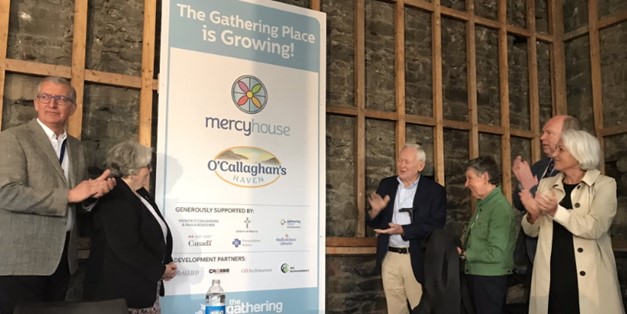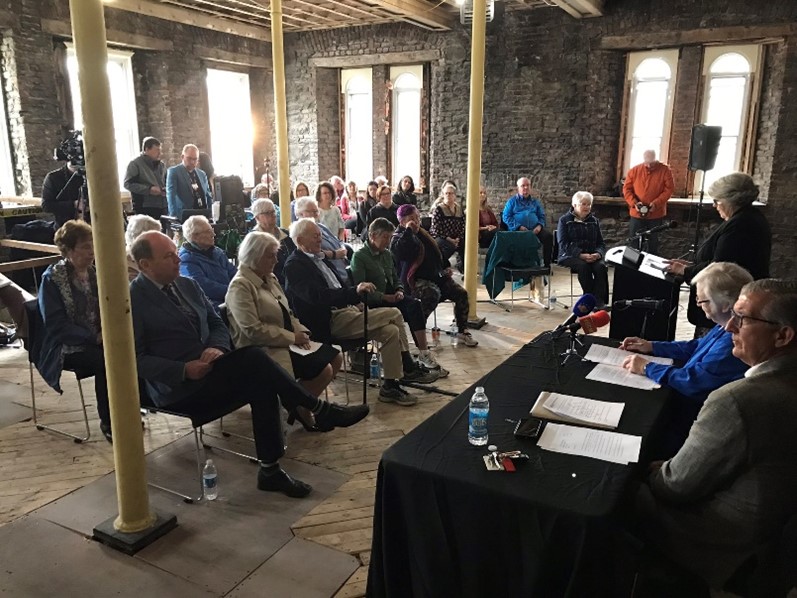McAuley Convent was opened in 1991 to provide a residence and center of care of the sick and infirm members of our congregation.
This modern and tastefully decorated building is built into the hillside of the Littledale property in the Waterford River valley in the west end of St. John’s. Every floor of the three-storey building has a ground level entrance. The center courtyard, which can be viewed from every room on the back of the building and which can be entered from the community room, is lavishly landscaped with flowers, shrubs and trees. Sisters can safely walk around the garden or sit in the swing chairs or other chairs that are provided. A statue of Mary stands at the centre of the garden and the Stations of the Cross are located on one side of the garden.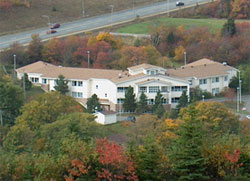
There are three other smaller community rooms for different groups of sisters, including one for the sisters who are part of the staff at McAuley Convent. In addition to this there are two large dining rooms, individual bedrooms, a physio-therapy room and a few multi-use rooms for arts and crafts, games, meetings or solitude. A very large kitchen, storage and laundry take up the lowest floor of the building. The crown of the building is the beautiful chapel with a wall of windows that look out to the Southside Hills of the Waterford Valley. The Sisters are blessed to have mass celebrated every morning and those who cannot go to the chapel may hear the celebration in their bedrooms.
Besides being the residence for sisters who need care in their old age, McAuley is a place of recuperation for sisters who have surgery or injury that requires more care than is available in their own convent. Our sisters are given the best of care and receive wonderful attentiveness from the many lay staff and sisters. Some have lived to see 100 years or more. When a sister is dying the sisters who are able, keep day and night vigil. Sisters are prayed into God’s kingdom at the end of their lives.
McAuley Convent is a place of care, safety and nurturing; it is a place of faith, joy, freedom and celebration. It is a powerhouse of prayer for the many needs of individuals and for our world.
McAuley Convent closed in October, 2020 when the sisters needing care moved to the Residence at Littledale, a new facility owed and operated by a local businessman Fred Cahill, on the Littledale Property where we are renting the entire third floor.
El Convento McAuley se inauguró en 1991 para proporcionar una residencia y un centro de atención a los miembros enfermos y desvalidos de nuestra congregación.
Este edificio moderno y decorado con gusto está construido en la ladera de la propiedad de Littledale, en el valle del río Waterford, en el extremo oeste de St. Cada planta del edificio de tres pisos tiene una entrada a nivel del suelo. El patio central, que puede verse desde todas las habitaciones de la parte trasera del edificio y al que se accede desde la sala comunitaria, está profusamente ajardinado con flores, arbustos y árboles. Las hermanas pueden pasear sin peligro por el jardín o sentarse en los columpios u otras sillas que se proporcionan. Una estatua de María se alza en el centro del jardín y el Vía Crucis está situado en uno de sus lados.
Hay otras tres salas comunitarias más pequeñas para diferentes grupos de hermanas, incluida una para las hermanas que forman parte del personal del convento de McAuley. Además, hay dos grandes comedores, dormitorios individuales, una sala de fisioterapia y algunas salas multiusos para manualidades, juegos, reuniones o soledad. Una cocina muy grande, el almacén y la lavandería ocupan la planta más baja del edificio. La corona del edificio es la hermosa capilla con una pared de ventanas que dan a las colinas del sur del valle de Waterford. Las hermanas tienen la suerte de que se celebre misa todas las mañanas y las que no pueden ir a la capilla pueden oír la celebración en sus habitaciones.
Además de ser la residencia de las hermanas que necesitan cuidados en su vejez, McAuley es un lugar de recuperación para las hermanas que han sufrido una intervención quirúrgica o una lesión que requiere más cuidados de los que pueden recibir en su propio convento. Nuestras hermanas reciben los mejores cuidados y una atención maravillosa por parte del numeroso personal laico y de las hermanas. Algunas han vivido 100 años o más. Cuando una hermana se está muriendo, las hermanas que pueden velan día y noche. Al final de sus vidas, se reza por las hermanas para que entren en el reino de Dios.
El convento de McAuley es un lugar de cuidado, seguridad y crianza; es un lugar de fe, alegría, libertad y celebración. Es un centro de oración por las muchas necesidades de las personas y de nuestro mundo.
El Convento McAuley cerró en octubre de 2020, cuando las hermanas que necesitaban cuidados se trasladaron a la Residencia de Littledale, una nueva instalación propiedad de Fred Cahill, un empresario local, que la gestiona, en la propiedad Littledale donde estamos alquilando todo el tercer piso.



 Discovering and using your strengths to deal with personal and family life issues . . . Support to see you through . . .
Discovering and using your strengths to deal with personal and family life issues . . . Support to see you through . . .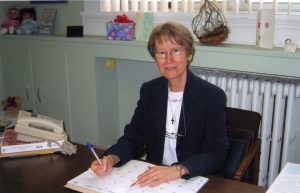 Sister Loretta Walsh, rsm, Executive Director of the Family Life Bureau, is a facilitator and counselor. She and two other certified counselors provide individual, couple, group and family counseling. They also organize and facilitate workshops and marriage preparation seminars. The workshops deal with issues related to family life, parenting, interpersonal relationships, separation and divorce, personal growth, youth, dealing with drugs, assertiveness and self-esteem.
Sister Loretta Walsh, rsm, Executive Director of the Family Life Bureau, is a facilitator and counselor. She and two other certified counselors provide individual, couple, group and family counseling. They also organize and facilitate workshops and marriage preparation seminars. The workshops deal with issues related to family life, parenting, interpersonal relationships, separation and divorce, personal growth, youth, dealing with drugs, assertiveness and self-esteem. SoulWinds is the home of
SoulWinds is the home of 
 Food Banks have evolved in our society to serve the needs of the poor and those who find themselves in a financial crisis and lacking food. Many of our sisters throughout the province of Newfoundland and Labrador commit themselves on a regular basis to setting up, managing or volunteering their time in food banks.
Food Banks have evolved in our society to serve the needs of the poor and those who find themselves in a financial crisis and lacking food. Many of our sisters throughout the province of Newfoundland and Labrador commit themselves on a regular basis to setting up, managing or volunteering their time in food banks. Immediately on their arrival in St. John’s the three founding members of the Newfoundland mission, Sisters
Immediately on their arrival in St. John’s the three founding members of the Newfoundland mission, Sisters 











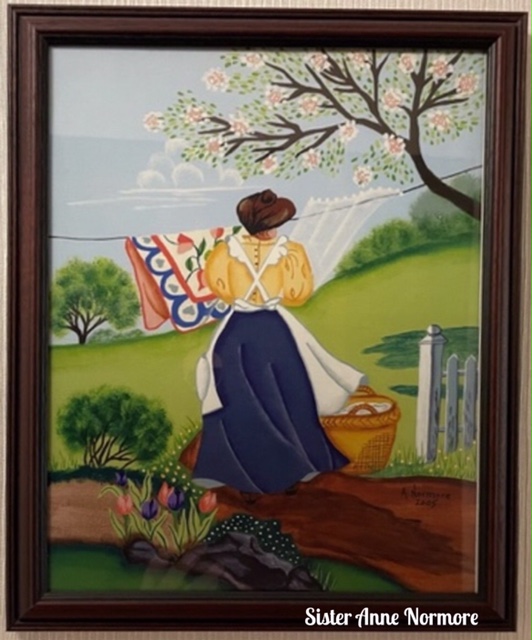

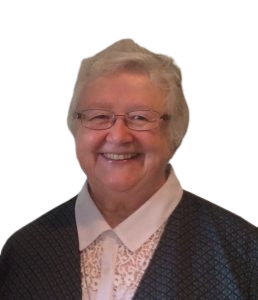 Sister Elizabeth’s reflections are published online in the Spirituality section under the appropriate liturgical season. They can be read online or downloaded.
Sister Elizabeth’s reflections are published online in the Spirituality section under the appropriate liturgical season. They can be read online or downloaded. Las reflexiones de la Hermana Elizabeth se publican en línea en la sección de Espiritualidad bajo el tiempo litúrgico correspondiente. Pueden leerse en línea o descargarse.
Las reflexiones de la Hermana Elizabeth se publican en línea en la sección de Espiritualidad bajo el tiempo litúrgico correspondiente. Pueden leerse en línea o descargarse.